Written by Joe Pranevich
 |
| Smaug looms large in the Hobbit. |
“In a hole in the ground, there lived a hobbit.” With those words in 1937, J. R. R. Tolkien launched a fantasy series that arguably changed the face of genre fiction for all time. Bilbo Baggins, the titular “hobbit” (or halfling) is joined by a wizard and some dwarves to travel across the land, through caves and forests, to defeat a dragon and claim its treasure. Along the way he meets the sage elf Elrond and his hidden valley, lunches with a were-bear named Beorn, catches a ride on some eagles, and plays a riddle game on a hidden lakeshore deep underground. It’s a fantastic book, one of the first novels that I can remember falling in love with as a child. Tolkien followed up his children’s novel with a more mature and intricate sequel trilogy,
The Lord of the Rings, between 1954 and 1955. In the years after his death, the Tolkien estate have released two further novels,
The Silmarillion (1977) and
The Children of Húrin (2007), short stories and poetry, as well as drafts and unfinished portions of yet more stories.
The Hobbit itself was adapted into an animated film in 1977 and then, against all common-sense, made into a trilogy of films by Peter Jackson between 2012 and 2014. While some might argue that you should not transform a 293-page children’s novel into nearly eight hours of film, the movies collected nearly three billion dollars at the box office. How can you argue with that? Even if you believe that modern fantasy would exist even without Tolkien, you have to admit one thing: he changed the plural of dwarf from “dwarfs” to “dwarves”. No kidding.
Box office brilliance was still well in the future in 1982 when Beam Software and Melbourne House produced their own version of
The Hobbit, an illustrated adventure originally for the ZX Spectrum. At a time when text adventures were still cutting-edge, they produced a game engine that that supported full sentences, an in-game physics system, and simple AI-based NPCs. The last of these can’t be over emphasized: every character in the system pretty much does its own thing, whether you are watching or not. As a side-effect, the game has a reputation for becoming unwinnable because key characters can go off and die without you noticing; I look forward to playing and seeing whether that criticism is well-deserved. Whatever the reason,
The Hobbit stands out as one of the most popular adventure games of that era with more than a million copies sold. When it comes to “Missed Classics”, I don’t think we can get any more classic than this one.
 |
| Original box art with much scarier dragon. |
The game was developed by Beam Software with in-game credits going to Philip Mitchell and Veronika Megler. Mr. Mitchell and Ms. Megler were both students at the University of Melbourne during the 18-months it took to complete the game. Ms. Megler was the brains behind the engine, but she did not remain in game design after completing her degree, instead pursuing a career as a Big Data architect with IBM and then Amazon. She is only credited for one more game, the action game
Penetrator (1983) for the Spectrum. Mr. Mitchell remained in the game industry for a number of years and I look forward to following him to his next adventure game,
Sherlock (1984) in a few months. After that one, he appears to have devoted his career to Tolkien sequels, completing the final game in the cycle in 1989. He continued with Beam as a programmer and manager for a decade after that, but I have been unable to track down any recent projects. Other programmers credited in the manual include Alfred Milgrom and Stuart Ritchie, plus art by Kent Rees. Mr. Milgrom was one of the founders of Beam Software (the “AM” in “BEAM” were his initials) and worked on many of their games as a producer or programmer. The only game of his we might play would be
The Dame was Loaded from 1995, but he was only credited for “original concept”. (Mr. Mitchell also worked on that project, porting it to the CDi and Macs.) Alfred Milgrom should not be confused with the Al Milgrom that we just met in our
Questprobe read-through! Mr. Ritchie and Mr. Rees do not appear to have any subsequent video game credits.
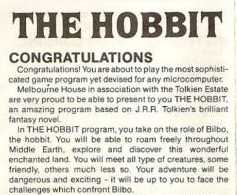 |
| “The most sophisticated game program yet devised for any microcomputer.” |
Speaking of sequels,
The Hobbit spawned at least three:
The Lord of the Rings: Game One (1985),
The Shadows of Mordor (1988), and
The Cracks of Doom (1989). To add to the confusion, the first was released under a different title internationally (
The Fellowship of the Ring, naturally enough) and the third was never released in the UK. The international editions of
The Hobbit, released starting in 1983, also featured enhanced graphics and puzzles. I will be playing the original UK edition, but I also plan to take a peek at the US version when I’m done. The series was parodied by the CRL group in
Bored of the Rings (1985) and
The Boggit (1986). Playing all of those games would be an amazing set of “Missed Classics”, but just like the Al Lowe games that I so desperately want to try, I’m going to have to leave them for an adventurer with a bit more free time.
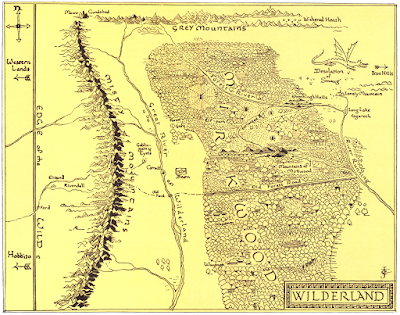 |
| A very useful map! |
The manual for this game is nothing special, a five-columned pamphlet explaining the overall story and offering an introduction to text adventures. The goals of the game are two-fold: get the dragon’s treasure safely back to your home and keep Thorin alive while doing so. (The latter might be a surprise for those of you that read the book.) The pamphlet also introduces us to three Melbourne House buzzwords, so indicated because they are in ALL CAPS whenever they appear: INGRISH, ANIMACTION, and ANIMTALK. INGRISH is the English-like sentence parser which seems pretty advanced for its time, roughly on par with contemporaneous work done by Infocom but ahead of most of the competition. ANIMACTION is their word for the self-driving NPCs and the emergent gameplay that results; I am especially eager to see this in action. Finally, ANIMTALK is just the idea that you can give commands to the NPCs to perform actions, another feature already present in Infocom games of the era.
The game’s most surprising “extra” is a complete copy of
The Hobbit, the original novel. The manual encourages players to use the map at the beginning of the book for navigating the game, and the rest of the story should be considered something of a “hint book”, even though it insists that some puzzle solutions will be different.
Enough research! Let’s play the game already.
An Encounter with Trolls
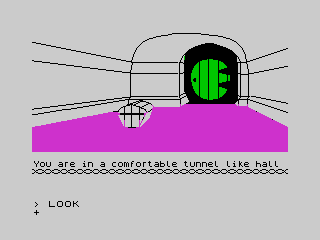 |
| The adventure begins! |
The game opens inside the famous “hole in the ground” that was Bilbo’s home. Thorin and Gandalf are both here, but there isn’t a ton of exposition. Gandalf hands us a map that we cannot read and before we know it, we are off on an adventure. Unless they appear later, this game has dramatically cut back on the number of dwarves: the book featured 12 traveling together, but right now we only see Thorin. Just outside Bilbo’s house is a gloomy landscape that does not seem at all like the Shire. In fact, it suggests that Bilbo lives quite alone! Only one screen later, we find our first puzzle: a group of trolls.
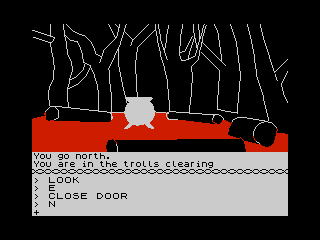 |
| It’s like a Troll Scout jamboree! |
It’s surprising how condensed this game is so far: only two screens from the start and we are already at the troll’s clearing! As I arrive, they recite some dialog from the book, complaining that eating Bilbo will be hardly more than a mouthful. Looking around, we spy that there is a large key on the ground and that must be useful for something. In the books, Bilbo tries to be a “burglar” so I take that approach first… with predictable results. We try to take the key, the trolls kill us. The end. When you die, the game gives you a score readout: I explored 2.5% of the game! Not exactly a promising start.
But, you might ask, what are Thorin and Gandalf doing while Bilbo is facing off against trolls alone? Not much, it seems. Gandalf has already disappeared, while Thorin “sits down and starts singing about gold”. Since Bilbo needed Gandalf’s help to defeat the trolls in the book, I head off to find him two screens away. Using that ANIMTALK magic (patent pending), I order him to head back to the trolls clearing. I get him in with the trolls, but he does absolutely nothing useful. I still die. Is the solution elsewhere? I explore further and find a hidden path in the woods with some troll tracks leading to a locked door. That’s obviously where the key goes, but still no way to get the key. I’ll have to keep searching.
I resume heading east and before long arrive at Rivendell. In the book, this “Last Homely House” is a beauty to behold, a refuge of music and elves in a hidden valley. In the game, it’s a disappointing room with no description or graphics. Elrond is hanging around, so I follow what I remember from the book and ask him to read my map. “Go east from the forest gate to get to the bewitched gloomy place,” he says. I assume I’ll know what that means when I get there. He also provides us with a packed lunch. While this is happening, I also get an unexpected message that the “day has dawned”. What? Was I playing the whole game so far in the dark? But I think I know what this means: I race back to the troll’s clearing and find that they have been turned to stone by the daylight.
I’m not sure that I like this puzzle much. In the book, Bilbo has to distract the trolls so they don’t realize that day is dawning, plus get an assist from Gandalf at the end. Here, you just sort of go about your business until daybreak and then come back and find them dead. There’s a missed opportunity here. I snatch the key and unlock the troll’s cave to discover a sword and some rope. Those will probably come in handy!
The Misty Mountains
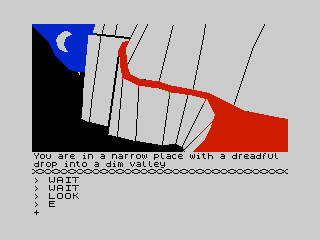 |
| At least the moon doesn’t have stars behind it. |
Just east of Elrond’s house is the Misty Mountains. In the book, this is where Bilbo proves himself for the first time as he “riddles in the dark” for his freedom from Gollum and manages to find the One Ring. In this game, the area makes up a large set-piece, a connected set of mazes and puzzles for you to solve before heading further east. Rather than just describe the area “in the moment”, I need to step back and give you a brief idea of what I was getting myself into. Much of this I didn’t quite work out until later, but presenting it upfront will save us from paragraph after paragraph of described befuddlement.
The Misty Mountains turns out to be a collection of two separate, but connected, mazes. Mazes here do not work like they did in
Colossal Cave and similar games. Many game mazes of this era consisted of a group of identical rooms connected in seemingly-random ways. To map them, you drop an item in each location to make them unique and keep track of which exits lead back to which items. Since dropped items in this game are liable to be moved by the random NPCs wandering around, the designers took a different approach. Instead, the rooms are only mostly the same: they each have a distinct name and set of exits. For example, there will be only one room called “Narrow Path” with exits to the east, northeast, and south. Since exits are still not straightforward-- heading west then east will usually not bring you back to the start-- you have to carefully check every exit from every room. It is easier to map than “passages all alike”, but still quite challenging.
The first maze is the mountains’ exterior, a warm-up exercise for the challenges in the caves. This one turns out to be eleven rooms named either “Narrow Path” or “Steep Path” with one clear objective: a golden key in a hidden valley. Along the way, we also discovered a cave containing a suspicious looking “small crack”. Every now and then, the crack opens to reveal a goblin. As soon as the goblin appears, I type “go crack” and we manage to get by him and into the second maze.
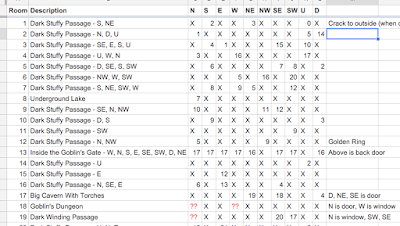 |
| My interior map, thanks to the power of spreadsheets. |
The interior maze is where the real fun begins, though it took me quite some time to map it fully. This time, we have twenty-one connected rooms, most of which are “Dark Stuffy Passages”, but with a handful of special locations mixed in. Mapping is made more complicated not only by the number of rooms, but also by the random wandering goblins which can capture or kill you. When Bilbo is captured, he is taken to a dungeon deep in the mountain. It took me a very long time to figure out how to escape from the trap and I eventually just resorted to restoring a saved game every time I’d get thrown in, just so I could keep mapping. It was frustrating work, but bit by bit we made progress. And thankfully, there was more than enough to discover in the maze itself to keep it interesting.
But… I spent a lot of time in the dungeon. On the surface, it’s not that complex of a puzzle: there is a locked door that neither of my keys open, a window, and a pile of sand. On my first time getting thrown in the slammer, I find that Gandalf was also captured! He just disappears for long periods of time, so maybe he wandered somewhere that he shouldn’t have. Still, I can’t imagine the Gandalf of the book giving too much thought to a couple of goblins. The window seems like our best choice for escaping. It’s too high for Bilbo to reach, but Gandalf is taller and he has no problem opening it. But before I can celebrate my victory, the wizard climbs out the window and leaves me to my misery. He doesn’t come back. What a lousy wizard.
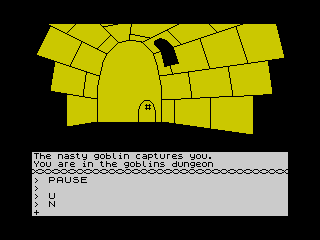 |
| The goblins’ dungeon is secretly an igloo? |
Fortunately, while we were playing around with the window Thorin must also have been captured because he showed up. Even though dwarves are pretty short, they are still taller than hobbits and he had no problem reaching the window. He climbs out, but unlike Gandalf, he comes back in again. As we try to puzzle this out, Thorin tells me to “hurry up” or gets bored and goes back to singing about gold. He’s no help. I’m fairly certain the solution involves having Thorin give Bilbo a boost up to the window, but if that’s it I can’t quite make the game understand what I want.
That leaves the sand pit. With just a bit of experimentation, I find that I can dig in the sand to reveal a trapdoor. It’s locked and again neither of my keys open it. A bit later (and in an act of frustration), I discover that I can break the trap door with my sword. That plunges the room into darkness and Bilbo dies after a few turns. The game doesn’t say this-- at all-- but the sword that Bilbo found in the troll’s cave glows when near goblins and it has been acting as my light source. It would have been nice to be told about that! After restoring, I ask Thorin to do my dirty work instead and he is able to break the door. Inside is a “curious” key (to match the “curious” map?), which Thorin says originally belonged to his father. That sounds important! Unfortunately, this is still a dead end for me as I still don’t know how to escape with the key. I restore back to before I was captured and continue exploring the maze.
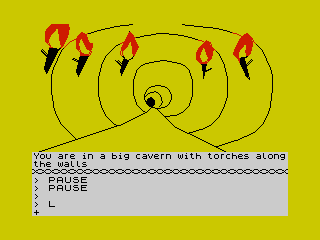 |
| Look! A different room in the maze! |
Since I was stuck in the dungeon, I concentrated on mapping the rest of the mountain maze. It was slow going, but I did find some interesting things:
- An “Underground Lake” where Gollum lives and swims around. I actually found Gollum a few other times while exploring, but I tried to avoid him. He asks what I have in my pockets and I run like hell.
- Rooms labeled “Big Cavern With Torches” and “Dark Winding Passage” turn out to be where the dungeon is; the door to the dungeon is in the big cavern while the window looks out on the winding passage. I can get into the cell this way, but I still can’t get back out. In a stroke of brilliance, I try instructing Thorin to go in, dig, break the door, get the key, and come back out. Let’s just say that didn’t work, but I’m not sure if it’s because complex commands don’t work or if Thorin would just get bored somewhere in the middle and say “no”.
- The golden ring is lying on the ground in an otherwise unimportant room. I pick it up because rings of power always come in handy.
- “Inside the Goblin’s Gate” is the so-called backdoor to the mountain, the exit that I remember Bilbo using in the book. I can open the door and escape if I want.
The ring in this game doesn’t work exactly as you expect. When you put it on, it only lasts a few turns before you have to put it on again. Sometimes funny things happen (Thorin exclaims “Where is the Thief!”), but I find it is quite effective for getting past goblins. Once you have it, Gollum seems to be more aggressive and he sneaks up behind me a few times to strangle me, but if I keep moving I can stay ahead of him.
Eventually, I explore the whole maze and get the ring, but still cannot crack the dungeon puzzle. Since I seem to need a key that I don’t have, I elect to march forward in the hope of finding it further along in the game. Leaving the goblins’ cave takes you first to Beorn’s house (but he isn’t home) and then to the entrance to Mirkwood. But that also seems like a pretty good place to stop for this post.
 |
| The foreboding forest will have to wait for next week. |
Before I go, I just want to stress how random this game can be at times. In my numerous attempts to map the maze, I had occasions when Elrond (!!) would be captured by the goblins, where there was a warg imprisoned with me, and times when Gandalf or Thorin would be around or not. Breaking the trap door also turns out to be harder than I thought: on a subsequent restore, it took me dozens of attempts to break through. It’s largely random (and, I later found out, based on how injured you and Thorin are from battling goblins). This is disheartening because if I am doing the right thing, but it still fails 90% of the time, I will never know. I could be typing the exact right things and the game decides not to let it work. It’s certainly going to make solving puzzles more difficult.
Next week, I’ll kick some dragon butt. Don’t forget that this is an introductory post so you can still guess the score or make wagers even though I made it through a fair chunk of the game this time. Since many of you played the international version of the game, let’s make it fair: you can guess TWO scores. I’ll do PISSED ratings for both versions of the game and you can get CAPs based on correctly guessing either or both of them.
See you next week!













With luck, TBD will have the font issues straightened out shortly.
ReplyDeleteI know this one was more a classic in the UK than in the US (I had not heard of it). Have any of our European gamers played this? Or did I just miss out?
Actually I thought it looked great as it was. All strangely compressed and with a few randomly highlighted paragraphs to keep you guessing. I even managed to get one of the captions to appear in the same colour as the background.
DeleteIt was a work of art! But I'm a boring old stooge.
DeleteI didn't play this at that time, but in my defense I have to say that:
Delete- I don't think it was translated to spanish
- I don't think it was released for the computer I had (MSX)
- I was just 8 years old in 1982, and I didn't get my computer until 1986
For the record, I have refused so far to watch Jackson's bloated Hobbit.
30 for me (UK version)
The MSX did not receive this version, but it was one of the first platforms to get the re-release in 1983. I discuss the re-release in my next post, but it's essentially a much shinier version of this game with a few bugs fixed and some expansion of the endgame.
DeleteIf you didn't find a way out of the goblin dungeon I could tell you!
DeleteI've played Hobbit only very much after its days of fame. Having read contemporary reviews, I expected something awe inspiring, but what I found - mostly frustrating and very dated. I guess the pretty graphics were the selling point back then - since Apple II wasn't a big thing in Europe, we didn't get Sierra's text adventures here, so Hobbit was the first adventure game with pictures.
ReplyDeleteI'll predict 32.
I actually played this a bit back in the day (never got out of the goblin's dungeon). I remember being amused and impressed at the fact that NPCs had their own schedule and would move independently. In retrospective it's clear it doesn't work that well but just goes to show how things we take for granted now had a much larger impact when they appeared.
DeleteThe goblin's dungeon is an impressive edifice, and very challenging if you don't approach it in a systematic way. It must have been worse on a real system when load times was much slower. BUT, I actually like it quite a bit. It's a much more interesting and perhaps organic space than other games' mazes. There are interesting places to find, at any rate, and it is true to the book.
DeleteThe Digital Antiquarian covered this game a year or so ago and uncovered information suggesting that the contributions of Veronika Megler to this game were the major ones.
ReplyDeleteOh yes, I found that as well in a few places. I tried to out to Veronika to discuss, see if she wanted to do an interview, but I haven't quite been able to get working contact information. Oh well.
DeleteI know that she wasn't involved in "Sherlock", Mr. Mitchell's next game, and from what I can tell -- SO FAR -- it is worse for it. But I've just scratched the surface of that game and am hesitant to prejudge it so early. (As for when my "Sherlock" review will hit this site, I am not sure. I think I need to flip to "Cruise for a Corpse" before I will finish it.)
She's on LinkedIn: https://www.linkedin.com/in/veronikamegler
DeleteI'll guess 35.
ReplyDeleteI played this a little bit on the C-64 but didn't get very far. The only thing I remember is the starting screen with the double-pacman door.
Don't forget that you can get two guesses here. If I were gaming the system, I'd pick a number and then maybe a handful more for the remake. Double your chances for CAPs! :)
ReplyDeleteIn that case, I'll bet 35 and 41!
DeleteIf I knew more about statistics I'd probably say something clever like, an average of 38 with a distribution of 6, but I'm pretty sure that's using statistical terms incorrectly.
If anyone wants to point out a correct way of statistically saying that, I'd love to hear it!
37
ReplyDelete34 for one, and 38 for the other
ReplyDeleteI'm going with 29 for both in the hopes that the lower spectrum is being under represented.
ReplyDeleteWhat a fascinating, but strange game. 25 for this version and 35 for the other. Why? I don't know. Who cares?
ReplyDeleteAnd I'm with Laertes: I, too, felt no need whatsoever to give Peter Jackson more money to ruin a classic adventure story.
I saw the first of the three, found it boring as all heck, and have not watched the other two.
Delete(But in contrast, I rather liked his LoTR films.)
@Joe
DeleteI did as well. In fact, I would go so far as to call them fantastic. But everything about the Hobbit turned me off from wanting to see them.
You can't deny that Freeman-Cumberbatch chemistry, though. Or can you?
DeleteI saw the first film and thought it was pretty bad. Felt like it doubled down on all of LotR's flaws. Got halfway through the second one before calling it quits. I'm not a Tolkien purist by any means and I couldn't care less about canon, but really, that forced romance between the elf and that "dwarf" who looked like a regular guy. Oh, and the river barrel chase scene. Good grief.
DeleteFreeman-Cumberbatch chemistry is good, but there's not that much of it in the whole bloated trilogy. I think the third film is especially grating - it's just one boring battle scene after another.
DeleteBut if there's one positive in the whole trilogy, it's Sylvester McCoy as Radagast. I'd love to see a spinoff-series based round the character. Perhaps using some magical blue box to fly around through time and space of Middle-Earth?
Oh the hobbit, I don't have a problem with splitting the movies into three since I can see if you still want to put everything from the books in the movies where each screen make the world condensed (pity the things they added from outside the books were not up to my taste). Still, only hobbit game I've played was the action-platformer game in the mid-2000's. So the dice say 43? I gonna say that's for the remake while I go 38 for the original.
ReplyDeleteDid you find a solution to the goblin dungeon? I could tell you if you didn't get out!!
ReplyDeleteWow, this game's art is just...bad. It looks like what a young child would draw if given crayons and asked to draw the bed time story their parent had read them. (My Dad read me the hobbit as a bedtime story).
ReplyDeleteI think this era has aged the worst of all computer graphics eras, followed by the early 3D era. And there isn't really a good reason for it, you should see what the Japanese microcomputer artists were able to do with what, 8 colours? 16? (I forget) and some VERY good dithering. But here? Bleh.
The only upside is no cyan/magenta.
DeleteI have this game for the speccy in its original case ( its looking like a book) ,completely with the fellowship of the ring book. I was so excited when i bought it, but never finished it
ReplyDeleteOfc i was wrong. I was talking about the fellowship of the ring, not the hobbit
DeleteRe the goblin dungeon. This whole scene is CARRIED by thorin. You'll get high with a little help from your friends.
ReplyDelete